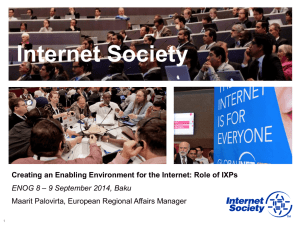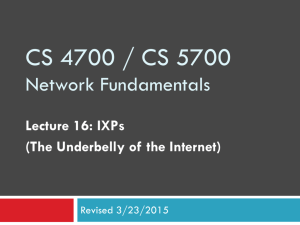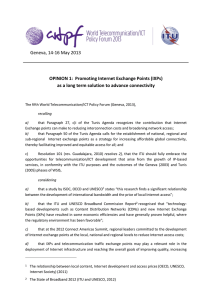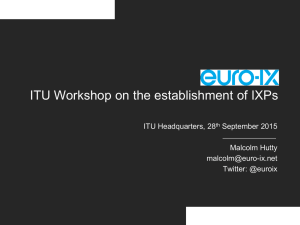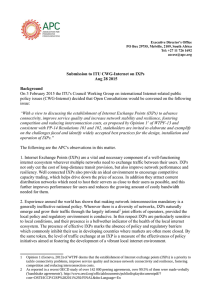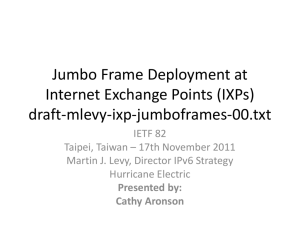ITU WORKSHOP ON APPORTIONMENT OF REVENUES AND
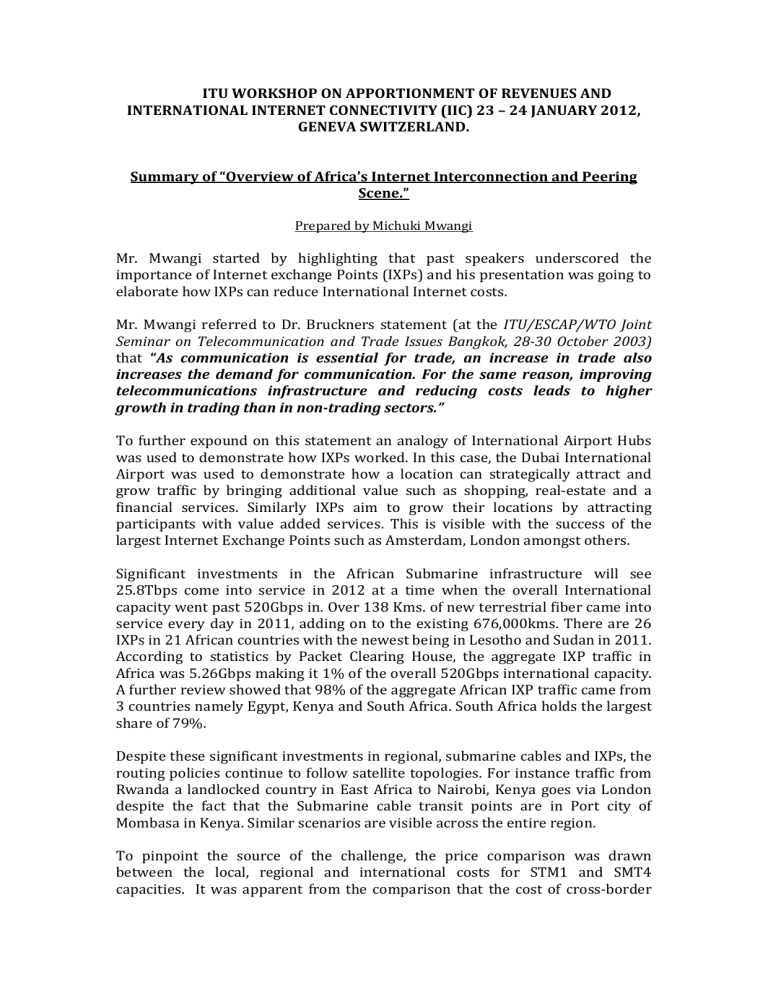
ITU WORKSHOP ON APPORTIONMENT OF REVENUES AND
INTERNATIONAL INTERNET CONNECTIVITY (IIC) 23 – 24 JANUARY 2012,
GENEVA SWITZERLAND.
Summary of “Overview of Africa’s Internet Interconnection and Peering
Scene.”
Prepared by Michuki Mwangi
Mr. Mwangi started by highlighting that past speakers underscored the importance of Internet exchange Points (IXPs) and his presentation was going to elaborate how IXPs can reduce International Internet costs.
Mr. Mwangi referred to Dr. Bruckners statement (at the ITU/ESCAP/WTO Joint
Seminar on Telecommunication and Trade Issues Bangkok, 28-30 October 2003) that “ As communication is essential for trade, an increase in trade also increases the demand for communication. For the same reason, improving telecommunications infrastructure and reducing costs leads to higher growth in trading than in non-trading sectors.”
To further expound on this statement an analogy of International Airport Hubs was used to demonstrate how IXPs worked. In this case, the Dubai International
Airport was used to demonstrate how a location can strategically attract and grow traffic by bringing additional value such as shopping, real-estate and a financial services. Similarly IXPs aim to grow their locations by attracting participants with value added services. This is visible with the success of the largest Internet Exchange Points such as Amsterdam, London amongst others.
Significant investments in the African Submarine infrastructure will see
25.8Tbps come into service in 2012 at a time when the overall International capacity went past 520Gbps in. Over 138 Kms. of new terrestrial fiber came into service every day in 2011, adding on to the existing 676,000kms. There are 26
IXPs in 21 African countries with the newest being in Lesotho and Sudan in 2011.
According to statistics by Packet Clearing House, the aggregate IXP traffic in
Africa was 5.26Gbps making it 1% of the overall 520Gbps international capacity.
A further review showed that 98% of the aggregate African IXP traffic came from
3 countries namely Egypt, Kenya and South Africa. South Africa holds the largest share of 79%.
Despite these significant investments in regional, submarine cables and IXPs, the routing policies continue to follow satellite topologies. For instance traffic from
Rwanda a landlocked country in East Africa to Nairobi, Kenya goes via London despite the fact that the Submarine cable transit points are in Port city of
Mombasa in Kenya. Similar scenarios are visible across the entire region.
To pinpoint the source of the challenge, the price comparison was drawn between the local, regional and international costs for STM1 and SMT4 capacities. It was apparent from the comparison that the cost of cross-border
capacity was insignificantly lower to that of International capacity. However, in
South Africa it was substantially higher than that of international capacity. As a result few operators would consider the business case for regional capacity due to the limited regional traffic and therefore prefer to have that traffic exchanged at International locations.
It was also evident that in Kenya the capacity costs were considerably lower than in South Africa. This was attributed to the diverse cable ownership models that had spurred competition and innovation.
To address the 1% local to 99% international traffic imbalance, there is a need to evaluate the IXP infrastructure with an aim to enhance the value derived from it.
It was highlighted that 61% of Africa lacks IXPs with West Africa having the least number of IXPs. However, contrary to assumptions, IXP setup costs are low due to the support accorded by many Internet organizations locally, regionally and
Internationally. For instance the setup of the Lesotho Internet Exchange Point in
2011 and supported by the Internet Society, demonstrated that the cash expenses were below $5,000 with an additional similar amount received through in-kind contributions.
Further, majority of the operational IXPs fall under the category of “Boxes and
Wires” with the rest considered to be providing “Core Functionality”. A few can be considered to be “Catalyzing Growth” or “Thriving Critical Infrastructure”. In order to spur growth, IXPs will need to attract participation beyond the traditional members to include E-Governments, Research and Education networks and DNS services such as hosting the national country code top-level domain (ccTLD). In addition, IXPs will have to explore opportunities to leverage their facilities and membership to attract content providers caching servers and promote building of carrier neutral data centers.
Information asymmetry can be attributed to the higher costs of International
Internet connectivity costs. For instance, operators in Africa are lured to buy IP transit capacity from the nearest submarine cable landing stations, while buying raw capacity to strategic destinations such as Europe would offer better-cost margins, since at least 60% of the traffic can be peered at European IXPs and
40% acquired at the prevailing transit market rates. The Africa Peering and
Interconnection Forum (AfPIF) aims to address this information asymmetry by providing a platform where stakeholders can share experiences and best practice from the region and globally. The AfPIF event is in its 3 rd year and will hold its annual event in South Africa in 2012.
The evolution of national IXPs into regional IXPs will be vital in leveraging the
African “eyeballs” networks to attract content providers and global carriers to the region. The European experience has demonstrated that regional peering points evolved from national IXPs close to locations, served by multiple cable landings, which offered attractive environments similar to the airport analogy.
In this respect, Egypt, Kenya, South Africa, Nigeria and Senegal are strategically poised to evolve as regional interconnection hotspots.
The evolution of national IXPs into regional can be observed at the Kenya
Internet Exchange Point (KIXP) which was able to attract an 85% growth of cross-border networks between 2010 and 2011. However, there is insufficient data available to measure regional interconnection across all African IXPs or the percentage of regional traffic exchanged Internationally. It is encouraging to see that there is a start and potential business case for regional interconnection being developed in East Africa.
Despite these challenges, it is possible to measure the value of an Internet exchange point using the formulae developed by Bill Norton
( http://www.drpeering.net
) defined as the value of peering. The measure aims to identify what is the collective cost operators would have to pay if an IXP ceased to exist. In this case using examples of the Mozambique IXP and the
Kenyan IXP the values of $17,985 and $99,600 were collectively saved by peering at both IXPs respectively. The KIXP having more value due to the high traffic exchanged.
In conclusion Mr. Mwangi highlighted that Africa should aim to have a 70% local and 30% International traffic balance by focusing on the areas discussed in his presentation.
Question and Answer Session:
Q1: Representative from Ghana inquired on the strategies his government should consider to increase broadband in their country
A. The Government should consider ensuring that both terrestrial and submarine cable infrastructure ownership models are structured in a way that promotes competition and innovation. The success seen in the East Africa region is as a result of regulatory policies that allowed for competition on the infrastructure investments at the submarine and terrestrial infrastructure level.
Q2. Public sector policies that would help develop or promote the use of IXPs at national level.
A.
At the national level, every country is encouraged to develop policies that would fit its environment as there is no one size fits all policy with respect to
IXPs. For instance, in Singapore the Government obligates operators to interconnect at IXPs. While in Kenya it has been observed that tenders for
Internet Service Provider services have a requirement for bidders to be connected to the local Internet exchange.
Q3. Expand on the best management model of IXPs
A.
The best practice for setting up IXPs using a multi-stakeholder model. The stakeholders include Governments, Research and Education Networks, ISPs, ccTLDs, Content providers. In addition, an IXP should remain neutral and should
not engage in any business that potentially competes with its any of its members business opportunities.
Q4. Why is there a pricing difference between Kenya and Mombasa and that of South Africa.
A.
The pricing difference is as a result of the diverse cable ownership models in
Kenya. The TEAMS, EASSY and SEACOM cables all have a diverse ownership model. As a result all stakeholders public and private sector, including incumbents have stakes in some cables therefore creating triggering a competitive and innovative environment.
Q5. Representative from Cote D I’vore inquired if there are any plans to assist the Internet Exchange Points in Africa to grow as per the presentation.
A.
The Internet Society has an ongoing program that aims to assist IXPs in the
“boxes and wires” stage to achieve critical infrastructure status. The program is conducted in partnership with various organizations in the region such as
AfriNIC.
Q6. Are we receiving cooperation from Governments in our efforts to promote regional Interconnection.
A. We have received cooperation from Governments in our efforts. For instance the past 2 AfPIF events were recognized and or hosted by regulators in their respective countries. In addition, we have been engaging with regional organizations such as the African Union and the UN Economic Commission for
Africa (UNECA) and regional economic communities on the issues of crossborder interconnection.
